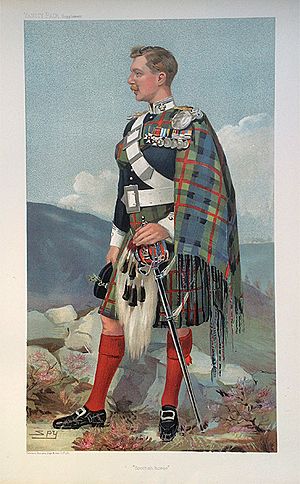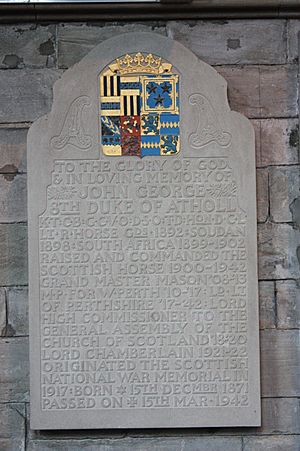John Stewart-Murray, 8th Duke of Atholl facts for kids
Quick facts for kids
The Duke of Atholl
|
|
|---|---|

Vanity Fair portrait by Spy (Leslie Ward), 23 March 1905.
|
|
| Nickname(s) | Bardie (short for Tullibardine) |
| Born | 15 December 1871 Blair Castle, Perthshire |
| Died | 16 March 1942 (aged 70) |
| Allegiance | |
| Service/ |
|
| Rank | Brigadier General |
| Unit | Royal Horse Guards Scottish Horse |
| Commands held | The Scottish Horse Brigade |
| Battles/wars | Siege of Khartoum Battle of Atbara Second Boer War First World War |
| Awards | Knight of the Order of the Thistle Knight Grand Cross of the Royal Victorian Order Companion of the Order of the Bath Distinguished Service Order |
| Spouse(s) | Katharine Ramsay |
| Other work | Unionist Member of Parliament Lord Chamberlain |
John George Stewart-Murray, the 8th Duke of Atholl, was an important British soldier and politician. He was born on December 15, 1871, and passed away on March 16, 1942. Before becoming Duke in 1917, he was known as the Marquess of Tullibardine.
Contents
Early Life and Education
John George Stewart-Murray was born at Blair Castle in Perthshire, Scotland. He was the second son of the 7th Duke of Atholl, but became the eldest surviving son. He went to school at Eton College, a famous boarding school.
Interestingly, he learned to speak Gaelic before he learned English. His wife, Katharine, mentioned in her book Working Partnership that he and his brothers and sisters were all taught Gaelic and were very good at it. He was also the President of An Comunn Gàidhealach, which is Scotland's national Gaelic society, from 1898 to 1904.
Military Career and Service
Joining the Royal Horse Guards
John George Stewart-Murray began his military career in the Royal Horse Guards. He became a second lieutenant in 1892 and was promoted to lieutenant in 1893.
He served in a military expedition led by General Kitchener in Sudan. He fought in important battles like the Siege of Khartoum and the Battle of Atbara. For his bravery, he received the Distinguished Service Order (DSO) in 1898. A year later, in 1899, he became a captain.
Fighting in the Second Boer War
In 1900, he served as an aide-de-camp (a personal assistant) to a general in Natal, South Africa. Later that year, he was promoted to major.
Lord Kitchener asked him to create a new regiment (a military unit) made up of Scottish soldiers in South Africa. This new group was called The Scottish Horse. It was formed very quickly and soon began fighting in the Western Transvaal region.
Because of its success, a second Scottish Horse regiment was created. John George Stewart-Murray was in charge of both regiments, which eventually grew into a whole brigade (a larger military unit) by the end of the Second Boer War. In 1901, he was given the rank of lieutenant colonel while leading the Scottish Horse.
Service in the First World War
During the First World War, also known as the Great War, Atholl commanded a Yeomanry Regiment. These soldiers fought on foot (without horses) in the Dardanelles campaign against the Turks. In 1918, he earned the rank of temporary brigadier general.
Continuing His Service
Even when he was 70 years old during the Second World War, Atholl joined the Home Guard. This was a defense organization for older citizens in the UK. He continued to be involved with the Scottish Horse as an Honorary Colonel until his death in 1942. He also played a key role in setting up the Scottish National War Memorial at Edinburgh Castle after the First World War.
Political Career and Public Service
As the Marquess of Tullibardine, Atholl was elected as a Unionist Member of Parliament (MP) for West Perthshire in 1910. He served in the House of Commons until 1917. That year, he became the 8th Duke of Atholl after his father passed away, which meant he took his seat in the House of Lords.
In 1918, he was made a Knight of the Order of the Thistle, a very high honor. He also served as Lord High Commissioner to the General Assembly of the Church of Scotland from 1918 to 1920. In 1921, he was appointed Lord Chamberlain of the Household by Prime Minister David Lloyd George. He held this important position until 1922.

Besides his military and political work, Atholl was also the Grand Master of Scottish Freemasons from 1908 to 1913. He was also an Aide-de-camp to King George V from 1920 to 1931. He was given the Freedom of the City of Edinburgh, a special honor. His wife wrote in her autobiography that Atholl was even considered as a possible candidate to become the King of Albania after meeting some delegates who were impressed by him.
The Duke's Lottery Initiative
In 1932, Atholl became well-known for starting a lottery. He wanted to raise money for British charities, especially hospitals. This was done to encourage people to support British causes instead of sending money overseas to lotteries like the Irish Free State Hospitals Sweepstakes.
Even though his lottery was seen as patriotic by many British people, he faced legal challenges. Despite this, his efforts to help British charities were widely admired.
Family Life
John George Stewart-Murray married Katharine Ramsay in London on July 20, 1899. His wife, Katharine, became a very successful politician herself. She had a long career in local government, served in the House of Commons, and even became a government minister.
The Duke and Duchess of Atholl did not have any children. John George Stewart-Murray passed away on March 16, 1942, at the age of 70. His youngest brother, James Stewart-Murray, became the 9th Duke of Atholl. His wife, Katharine, the Duchess of Atholl, passed away in October 1960 when she was 85 years old.

